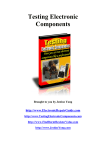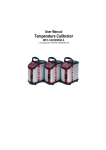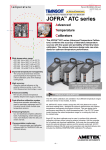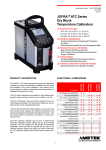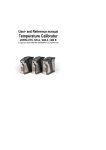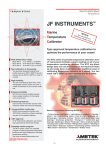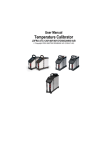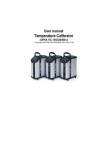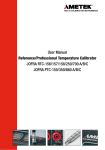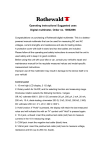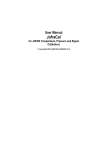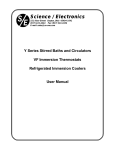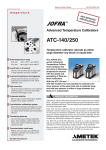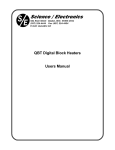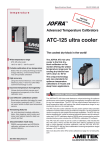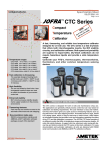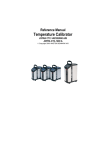Download Downloading - CERT-TRAK
Transcript
Reference Manual Temperature Calibrator JOFRA ATC-155/156/157/320/650 A/B Copyright 2002 AMETEK DENMARK A/S About this manual…. • The structure of the manual This reference manual is aimed at users who are familiar with Ametek calibrators, as well as those who are not. The manual is divided into 9 chapters. These describe how to set up, operate, service and maintain the calibrator. The technical specifications are described and accessories may be ordered from the list of accessories. Along with the calibrator, you should have received a multilingual user manual, which sets out the operating instructions for the instrument. It is designed to provide a quick reference guide for use in the field. • Safety symbols This manual contains a number of safety symbols designed to draw your attention to instructions that must be followed when using the instrument, as well as any risks involved. Warning Events that may compromise the safe use of the instrument and result in considerable personal or material damage. Caution… Events that may compromise the safe use of the instrument and result in slight personal or material damage. Note… Special situations which demand the user’s attention. 2 25-09-2002 105446 02 List of contents 1.0 2.0 3.0 Introduction ..............................................................................5 Safety instructions ...................................................................7 Setting up the calibrator ..........................................................8 3.1 3.2 3.3 3.4 4.0 Receipt of the calibrator................................................................ 8 Preparing the calibrator .............................................................. 10 Choice of insertion tube .............................................................. 11 Inserting the sensors .................................................................. 12 Operating the Calibrator ........................................................15 4.1 Keyboard, display and standard connections............................. 15 4.2 Input module (B versions only) ................................................... 18 4.3 Display readouts ......................................................................... 19 4.3.1 Main screen temperature values ................................... 20 4.3.2 Stability of temperature values ...................................... 20 4.4 SET temperature menu .............................................................. 21 4.5 Calibration menu......................................................................... 21 4.5.1 Running a calibration ..................................................... 22 4.5.2 Showing calibration results ............................................ 25 4.5.3 Displaying calibration information .................................. 26 4.6 Switch test menu ........................................................................ 27 4.6.1 Running a switch test..................................................... 29 4.6.2 Showing switch test results............................................ 30 4.7 Auto step menu........................................................................... 32 4.7.1 Running an Auto step calibration................................... 33 4.7.2 Auto step test results ..................................................... 34 4.8 Setup menu................................................................................. 36 4.8.1 Loading a setup ............................................................. 36 4.8.2 Saving a setup ............................................................... 37 4.8.3 Adjusting the display contrast ........................................ 37 4.8.4 Altering temperature display settings............................. 37 4.8.5 Setting the sensor input parameters (B versions only).. 40 4.8.6 Altering Stability criteria ................................................. 42 4.8.7 Setting the access code................................................. 43 4.8.8 Resetting the calibrator setup to factory defaults ......... 43 4.8.9 About the calibrator........................................................ 44 4.9 Simulation or training .................................................................. 44 5.0 Storing and transporting the calibrator ...............................46 105446 02 25-09-2002 3 6.0 Replacing the main fuses ......................................................48 6.1 Returning the calibrator for service............................................. 49 7.0 Maintenance............................................................................51 7.1 Cleaning...................................................................................... 51 7.2 Adjusting and calibrating the instrument..................................... 52 7.2.1 Introduction to AmeTrim-ATC Software......................... 52 7.2.2 Installing the AmeTrim-ATC Software ........................... 53 7.2.3 Connecting the PC and the Calibrator ........................... 53 7.2.4 Starting the AmeTrim-ATC Software ............................. 53 7.2.5 Temperature Adjustment ............................................... 55 7.2.6 Input Adjustment (B versions only) ................................ 60 7.2.7 Reference Sensor .......................................................... 65 7.2.8 Managing DTI sensor coefficients ................................. 67 7.2.9 Setup Printer .................................................................. 68 8.0 9.0 4 Technical specifications........................................................69 List of accessories .................................................................88 25-09-2002 105446 02 1.0 Introduction Congratulations on your new Ametek Jofra ATC Calibrator! With this Ametek Jofra calibrator, you have chosen an extremely effective instrument, which we hope will live up to all your expectations. Over the past many years, we have acquired extensive knowledge of industrial temperature calibration. This expertise is reflected in our products, which are all designed for daily use in an industrial environment. Please note that we would be very interested in hearing from you if you have any ideas or suggestions for changes to our products. This reference manual applies to the following instruments: • • • • • • • • • • ) Jofra ATC-155 A - Cooling calibrator Jofra ATC-155 B - Cooling calibrator with input panel Jofra ATC-156 A - Cooling calibrator Jofra ATC-156 B - Cooling calibrator with input panel Jofra ATC-157 A - Cooling calibrator Jofra ATC-157 B - Cooling calibrator with input panel Jofra ATC-320 A - Heating calibrator Jofra ATC-320 B - Heating calibrator with input panel Jofra ATC-650 A - Heating calibrator Jofra ATC-650 B - Heating calibrator with input panel ISO-9001 certified Ametek Denmark A/S was awarded the ISO-9001 certificate in September 1994 by BVQI - Bureau Veritas Quality International. 105446 02 25-09-2002 5 ) CE-label Your new calibrator bears the CE label and conforms to the EMC directive and the Lowvoltage Directive. ) Technical assistance Please contact the dealer from whom you acquired the instrument if you require technical assistance. ) Guarantee 1 year’s factory warranty. This guarantee only covers defects in manufacture and becomes void if the instrument has been subject to unauthorised intervention and/or misuse. 6 25-09-2002 105446 02 2.0 Safety instructions Read this manual carefully before using the instrument! Please follow the instructions and procedures described in this manual. They are designed to allow you to get the most out of your calibrator and avoid any personal injuries and/or damage to the instrument. Warning • • The calibrator must not be used for any purposes other than those described in this manual. The calibrator is designed for interior use only and should not be used in risk-prone areas, where vapour or gas leaks, etc. may constitute an explosives hazard. Caution – Hot surface This symbol is engraved in the grid plate. • Do not touch the grid plate, the well or the insertion tube as the calibrator is heating up – they may be very hot. • Do not touch the handle of the calibrator during use – it may be very hot. Note… The product liability only applies if the instrument is subject to a manufacturing defect. This liability becomes void if the user fails to follow the maintenance instructions set out in this manual or uses unauthorised spare parts. 105446 02 25-09-2002 7 3.0 Setting up the calibrator 3.1 Receipt of the calibrator When you receive the instrument… • Carefully unpack and check the calibrator and the accessories. • Check the parts against the list shown below. If any of the parts are missing or damaged, please contact the dealer who sold the calibrator. N ATIO IBR CAL INST RUM ENT S 9 8 7 ES You should receive: 6 5 4 C i 3 2 1 _ 0 • 1 calibrator • 1 mains cable • 2 sets of test cables (2 black, 2 red – B versions only) • 1 insertion tube (user specified) • 3 pcs. insulation plugs for 6, 10, 16 mm sensors (ATC-155 A/B and ATC-156 A/B only) or 3 pcs. insulation plugs for 5, 8, 11 mm sensors (ATC-157 A/B only) 8 25-09-2002 105446 02 • 1 CD-ROM containing software package “AmeCal Temperature” and "AmeTrim-ATC" adjustment software • 1 RS 232 serial cable • 1 tool for insertion tube • 1 traceable certificate (A versions) • 2 traceable certificates (B versions) • 1 reference manual Reference Manual • 1 user manual User Manual When reordering, please specify the parts number found in the list of accessories, section 9.0. 105446 02 25-09-2002 9 3.2 Preparing the calibrator Warning • • The calibrator must not be used in areas prone to explosives hazards. The calibrator must be kept clear within an area of 20 cm on all sides and 1 metre above the calibrator. Note… The instrument must not be exposed to draughts. MEN IO N IN TS STRU I BRAT CAL F4 F3 F2 F5 9 8 7 6 5 4 C ES i 3 2 1 _ 0 . F1 Fig. 1 When setting up the calibrator, you must… 10 Place the calibrator on an even horizontal surface in the spot you intend to use it. 25-09-2002 105446 02 Caution… Do not use the instrument if the ventilator is out of order. Ensure a free supply of air to the ventilator located at the bottom of the instrument. Check the voltage of the power control switch (on/off switch (230V/115V)). If the voltage of the power control switch differs from the line voltage, you must adjust the voltage of the power control switch as follows (see Fig. 1): A. Open the fuse box lid using a screwdriver. B. Take out the fuse box. C. Remove both fuses and insert two new fuses. These must be identical and should correspond to the line voltage. See section 9.0. B. Turn the fuse box 180° and slide it into place. Check that the earth connection for the instrument is present and attach the cable. g Select an insertion tube with the correct bore diameter. See section 3.3 for information on how to select insertion tubes. The calibrator is now ready for use. 3.3 Choice of insertion tube Caution… Before using new insertion tubes for calibration, the insertion tubes must be heated up to maximum temperature - 320°C (608°F) / 650°C (1202°F) - for a period of minimum 30 minutes. In order to ensure the best calibration of your sensors please avoid using insertion tubes in the ATC-320 calibrator which have been used in the ATC-650 calibrator. Insertion tubes are selected on the basis of the diameter of the sensor to be calibrated. 105446 02 25-09-2002 11 Use the table for insertion tubes in section 9.0 to find the correct parts number. Alternatively, you may order an undrilled insertion tube and drill the required hole yourself. The finished dimensions should be as follows: • Sensor diameter +0.2 +0.05/-0 mm. 3.4 Inserting the sensors Before inserting the sensors and switching on the calibrator, please note the following important warning: Warning • Never use heat transfer fluids such as silicone, oil, paste, etc. These fluids may penetrate the calibrator and cause damage or create poisonous fumes. Insert the sensors as shown in Fig. 2. 12 25-09-2002 105446 02 Sensor under test Reference sensor (if available) Insertion tube L IBR ATI ON INS T RU ME NT S F1 F3 F2 F4 ES F5 9 8 7 6 5 4 C i 3 2 1 _ 0 . CA Fig. 2 Caution… • • • • • 105446 02 The well and the insertion tube must be clean before use. Scratches and other damage to the insertion tubes should be avoided by storing the insertion tubes carefully when not in use. The insertion tube must never be forced into the well. The well could be damaged as a result, and the insertion tube may get stuck. Do not touch the grid plate, the well or the insertion tube while the calibrator is heating up – they may be very hot. Do not touch the tip of the sensor when it is removed from the insertion tube/well – it may be very hot. 25-09-2002 13 • 14 Do not touch the handle of the calibrator during use – it may be very hot. 25-09-2002 105446 02 4.0 Operating the Calibrator 4.1 Keyboard, display and standard connections Keyboard CALIBRATION INSTRUMENTS (heading) (icon) 1 (information) (functions) 2 6 5 3 4 Fig. 3 Pos. Description LCD. SOFT KEYS used to select menu options displayed in the LCD. ENTER KEY used to accept selected options or entered values. NUMERIC KEYS used to type in values. 105446 02 25-09-2002 15 INFORMATION KEY used to display the status of the parameters involved with the function currently selected. ESC KEY (escape key) used to cancel a selection/edit or return to previous menu. Display (heading) (icon) (information) (functions) Fig. 4 The Display is divided into four separate areas: • Heading: informs you of the current function selected. • Icon: indicates graphically the status of the calibrator • Information: provides the bulk of information and data in the selection. • Functions: informs you of the soft keys' functions. 16 25-09-2002 105446 02 Standard connections (all versions) Fuse 230V 5AF/115V 10AF 1 2 3 115V Sync. RS232 Fig. 5 Pos. Description Power control switch with a cable connection and on/off switch. It also contains the main fuse. See section 6.1 for information on how to change the fuses and section 3.2 to adjust the voltage setting of the power control switch. Connection for synchronization output. The state of the synchronization output is determined by the READ or TRUE temperature (dependent on the choice of reference sensor) by the following guidelines: • when the extended stability time is = 0 minute, the relay is switched on for 2 seconds when the stability is achieved. • when the extended stability time ≥ 1 minute for the internal reference sensor (READ), the relay is switched on in the last minute of the extended stability time. 105446 02 25-09-2002 17 4.2 Connection for RS232 communication. Input module (B versions only) Warning • The sockets on the input module must NEVER be connected to voltages exceeding 5V for the TC/RTD sockets and 45V for the mA/V sockets proportional to ground. • Thermostats must not be connected to any other voltage source during a test Description of sockets for external connections 8 + TC + Switch Test - - . 5V MAX . 45V MAX 7 6 + mA Act. + mA Pas. V + 5 4 3 Ref. Input 1 2 Fig. 6 18 25-09-2002 105446 02 Pos. Description Input for RTD sensor (2, 3 or 4 wire). Connection to chassis (earth/ground). Input for reference sensor. Voltage input. Passive mA input. Active mA input with 24V supply for transmitter. Connection for thermostat test. Note that this connection is for dead switches. TC connection for thermocouples. One of the inputs either , , , or can be selected displaying the “SENSOR” temperature in the Setup and can be displayed as “TRUE” temperature. Note: Only the sensor type, which is to be tested, should be connected to the input panel. 4.3 Display readouts Switch on the calibrator using the power control switch (pos. 1 in Fig. 5). The start up menu is displayed for approximately 2 seconds and is then replaced with the main menu screen: 105446 02 25-09-2002 19 The functions are available using the soft keys and are described in sections 4.4 to 4.8. 4.3.1 Main screen temperature values Two temperatures are displayed (A and B versions): • • READ temperature: this is the temperature measured by the internal reference sensor. SET temperature: this is the target temperature for the well. SET temperature displays the last value entered. If no value has been entered previously, "Not Activated" is displayed. Additional temperatures displayed (B versions only): • • SENSOR temperature: this is the temperature measured by the sensor being measured TRUE temperature: this is the temperature measured by an external reference sensor. This is only displayed when an external reference sensor is used and replaces READ temperature. 4.3.2 Stability of temperature values The stability of the READ, TRUE and SENSOR temperatures are indicated by the following messages: • • • "Not stable": indicates that the measured temperature is not yet within the specified stability criteria. "Time to stable": indicates that the temperature changes are within the specified stability criteria (see section 8.0) and states a time (in minutes) when the stable situation can be achieved. "9": indicates that the “stable” situation is achieved. • • 20 SENSOR temperature cannot indicate "9" unless the READ or the TRUE temperature is stable. If External reference (TRUE) is selected, the stability criteria will refer to this. As default the criteria are as follows: 25-09-2002 105446 02 The temperature must be within a range of ±0.03°C /0.05°F in 10 minutes to be stable. The criteria can be changed, however, if the temperature is set wider or the time is set shorter the calibrator may not reach the SET temperature. 4.4 SET temperature menu Press 4.5 . A cursor appears in the SET temperature field. Use the numeric keys to enter a new value, or existing value. to edit the Press to accept the value and return to the main menu screen. Calibration menu Note… This Calibration function is for B versions only. This function enables you to perform automatic calibrations of multiple temperature sensors. The calibration procedure is semi-automatic, using parameters and settings which are defined in work orders. These work orders are created and edited using the "AmeCal-Temperature" PC program. If multiple calibrations, using identical or similar settings, are required, the work orders can be replicated in the calibrator and labelled with a unique name. Press 105446 02 to select the Calibration menu. 25-09-2002 21 F1 F2 F3 F4 F5 Note: Calibration information is available in several places throughout the calibration menus. The content of this information is described in section 4.5.3. 4.5.1 Running a calibration Press F1 to select the Run calibration menu. F2 F3 F4 F5 Use and to scroll through the list and highlight an existing work order. Press to continue the calibration using the highlighted work order or, Press to create a copy of the work order. Then press to accept the new name. (Copies have the same name as the original work orders, but contain a suffix number, making the name unique.) 22 25-09-2002 105446 02 F1 F2 F3 F4 F5 to continue the calibration without editing the basic Press parameters or, Press to start the editor. F1 F2 F3 F4 F5 Make the necessary changes, exit the editor by pressing and continue the calibration by pressing . If the sensor under test is a thermocouple sensor and the manual compensation mode is selected in work orders, a cold junction temperature must be defined. Default value is 0,00°C (32°F) as if an ice bath is available. 105446 02 25-09-2002 23 Otherwise press to enter another value. Make the necessary changes, exit the editor by pressing continue the calibration by pressing . F1 F2 F3 F4 and F5 Press if you wish to overwrite the existing calibration and continue. If the work order is defined as a manual input, or used to determine when the values are to be entered. • • 24 are – to enter values during the calibration. – to enter values after the calibration. Follow the instructions on screen to connect the sensors and press to start the calibration. 25-09-2002 105446 02 all the The calibration can be stopped at any time, but this will erase calibration data. Follow the instructions on screen for repositioning the sensors (if an external manual heat source is used) and entering the step values (if manual input is required). When the calibration is complete, press or to store the results in the calibrator. The results can be viewed using the instructions in section 4.5.2. 4.5.2 Showing calibration results Press F1 to select the Show calibration menu. F2 F3 F4 F5 Use and to scroll through the list and highlight a specific work order. Press to display the calibration details for the selected work order. The calibration results can be uploaded with the “AmeCal Temperature” PC program. This enables you to print out the results on a certificate. Calibration result details This screen enables you to scroll through the calibration steps and view the actual SET, READ/TRUE and SENSOR temperatures for the individual calibration steps, together with the deviation and Pass/Fail status. 105446 02 25-09-2002 25 4.5.3 Press to exit the calibration details and return to the Show calibration results menu. Displaying calibration information Calibration information is defined within the work orders created on the PC using "AmeCal-Temperature". This information is divided in to six pages of information: Use and to scroll through the pages. The scroll wraps around, allowing you to go from page 6 to page 1 and vice versa. 26 25-09-2002 105446 02 Scenario (page 1) This shows the calibration setup in a graphic format. The parameters for this setup are defined in the work order created using the PC program. Basic parameters (page 2) This informs you how the calibration was registered, either "as found" or "as left" and the ambient air temperature (entered manually) at the time of the calibration. Notes (page 3) Information entered, via the PC program, when the work order is created. Sensor under test (page 4) If a Digital Temperature Indicator (DTI) is used, the "Measurement" field will display the DTI channel used. External reference sensor (page 5) This screen is only available when an external reference sensor is used. If a DTI is used, the "Measurement" field will display the DTI channel used. Calibration procedure (page 6) This shows the pre-defined temperature steps for the calibration. 4.6 Switch test menu Note… This Switch test function is for B versions only. Switch test automactically locates the switch temperatures of a thermostat. Three parameters are required: • Start temperature (T1) • End temperature (T2) • Rate of change in temperature (slope rate). 105446 02 25-09-2002 27 Hysteresis of a thermostat can also be determined here. Where the hysteresis determines the tolerence between the upper switch temperature and the lower switch temperature of the thermostat. Calibrator stable Heating with Slope Rate TOpen T [°C/°F] Cooling with Slope Rate T Close T2 TOpen THyste TClose Expected switch range for thermostat T1 Calibrator stable TStart t [min] Calibrator stable Shifting temperature Fig. 7 Press F1 in the main menu to select the Switch test menu. F2 F3 F4 F5 Two functions are available using the soft keys 28 25-09-2002 105446 02 4.6.1 Running a switch test Press F1 to select Run switch test. F2 F3 F4 F5 The small graph illustrates the current T1, T2 and hysteresis selections. Note that T1 can be greater than T2. Press a function soft key ( – ) to enable the editor. – To edit the first set temperature (T1). – To edit the second set temperature (T2). – To determine hysteresis, toggle between "Yes" (a two temperature measurement) and "No" (a single temperature measurement). – To edit the slope rate. The permitted range is 0.1 – 9.9°C/min. / 0.2 – 17.8°F/min. Note: the slope rate should be set so that the thermostat sensor can follow the temperature in the calibrator's well. Make the necessary changes and exit the editor by pressing . Press to start the switch test. While the switch test is in progress, three functions are available: – To show the current switch test results. This is described in section 4.6.2. – To review the switch test set up (no editing is possible). – To stop the switch test. 105446 02 25-09-2002 29 The calibrator's switch test procedure 1. Once the switch test is started, the calibrator starts working towards T1 as quickly as possible. The calibrator's temperature changes (heating or cooling) and switch status are shown in the display. 2. When T1 is achieved and the temperature is stable, a "9" is displayed for one second. 3. The calibrator now starts working towards T2 at the specified slope rate. 4. In a normal situation, the thermostat changes state before T2 is achieved. If T2 is achieved and the temperature is stable, "No Shift" result is displayed. 5. When hysteresis is not selected (single temperature change), the finished switch test result is displayed, see section 4.6.2. When hysteresis is selected (two switch changes), the calibrator starts working towards T1 at the specified slope rate. 6. Normally, the thermostat changes state before T1 is achieved. If T1 is reached and the temperature is stable, "No Shift" result is displayed. 7. The finished switch test results are displayed, see section 4.6.2. 4.6.2 Showing switch test results Two types of switch test results are available: • Results during a switch test. • Results of a finished switch test. 30 25-09-2002 105446 02 Results during a switch test Press F1 to select Show result. F2 F3 F4 F5 This shows the results that are currently available. These results change as the test progresses. Press to return to the switch test. Finished switch test results At the end of a switch test the results are displayed. These show the final result of the test and are known as the finished results. F1 F2 F3 F4 F5 Note: A hysteresis value is only displayed when hysteresis is selected. If either the first or second temperature displays "No shift", hysteresis displays "Error". For details, see section 6.0. When you exit the switch test, either by pressing or , these results are stored in the calibrator's memory. By pressing the results are not stored in the calibrator’s memory. 105446 02 25-09-2002 31 To view stored finished switch test results Press F1 to select Show results. F2 F3 F4 F5 Press a function soft key ( – ) to select the results for one of the last five tests. The data in the information field is the same as that displayed at the end of the switch test. 4.7 Auto step menu Auto step is used to step automatically between a range of different calibration temperatures. This is useful when calibrating sensors in places that are difficult to reach and sensors where the output is displayed in a different location. Time T [°C/°F] T4 T3 T2 T1 TStart t [min] Temperature stable Calibrator starts working towards next temperature Fig. 8 32 25-09-2002 105446 02 Press F1 to select the Auto step menu. F2 F3 F4 F5 Two functions are available using the soft keys 4.7.1 Running an Auto step calibration Press F1 to select Run auto step. F2 F3 F4 F5 Press to enable the editor to change the Auto step setup and step temperature values. • • • • 105446 02 No of steps: the number of temperature steps per direction (T1➨Tx) can be set using integers from 1 – 20. When a Two-way mode is selected, the same number of steps are used for the second direction (Tx➨T1). Mode: toggle between "One-way" and "Two-way". Hold time: defines the time (in minutes) the temperature is maintained (after it is stable) for each step. T step values: must be set within the sensors permitted range. 25-09-2002 33 Make the necessary changes and exit the editor by pressing . Press to start the Auto step test. While the step test is in progress, several functions are available: – To review the Auto step result (no editing is possible). – To pause the test. and – Force the test to jump a step (previous or next), regardless of the temperature step's stability. – To stop the Auto step test. When the Auto step test is complete the results are displayed. Press or to finish the test and store the results in the calibrator. The results can be viewed using the instructions in section 4.7.2. By pressing the results are not stored in the calibrator’s memory. 4.7.2 Auto step test results At the end of a Auto step test the results are displayed and stored in the calibrators memory. F1 F2 F3 F4 F5 The measured READ or TRUE and SENSOR temperatures for each step are displayed. 34 25-09-2002 105446 02 To view stored switch test results Press F1 to select Show results. F2 F3 F4 F5 Press a function soft key ( – ) to select one of the last five Auto step tests stored in the calibrator. 105446 02 25-09-2002 35 4.8 Setup menu Press to select the Setup menu. Nine fuctions are available. These are divided into three separate pages. Use the function key(s) labelled "more" to change page. Use the soft keys ( – ) to select the individual functions: page 1 page 2 page 3 F1 F2 F3 F4 F5 4.8.1 Loading a setup being Loading a setup causes all the parameters in the setup menu to be overwritten. 36 Press (setup page 1) to select Load setup. Use the keyboard to select a calibrator setup number (1–9). Press to load the selected setup. A warning informs you that the active setup will be overwritten. 25-09-2002 105446 02 Press if you are sure you want to overwrite the existing setup and return to the setup menu. 4.8.2 Saving a setup Saving a setup, saves all the parameters in the Setup menu. Press 4.8.3 Adjusting the display contrast Press (setup page 1) to select Save setup to registry. Use the keyboard to select a register number (1–9). Press to save the current setup in the selected register and return to the setup menu. (setup page 1) to select Display contrast. Press to make the display darker or display lighter. Press menu. to accept the new setting and return to the setup 4.8.4 Altering temperature display settings Press F1 to make the (setup page 1) to select the Temperature menu. F2 F3 F4 F5 Use the function soft keys to set the parameters displayed. 105446 02 25-09-2002 37 Setting the temperature units Press to select Unit. Press a function soft key to select the temperature units: - To select Celsius. - To select Fahrenheit. - To select Kelvin Press to accept the new setting. Setting the temperature resolution Press F1 to select temperature resolution. F2 F3 F4 F5 Press a function soft key ( type. Press a function soft key to set the resolution. – 1° resolution. – 0.1° resolution. – 0.01° resolution. – ) to select the temperature Press to accept the new setting and return to the temperature resolution menu. Setting the max. SET temperature 38 Press Press value. to select Max. SET temperature. . A cursor appears in the Max. SET temperature 25-09-2002 105446 02 Use the numeric keys to enter a new value, or press edit the existing value. to Press to accept the new setting and return to the Max. SET temperature menu. Converting electrical inputs to temperatures Press F1 to select the Conversion to temperatures menu. F2 F3 F4 F5 Setting voltage or current input conversions from the electric signal to a temperature reading. Press a function soft key ( input. Press a function soft key to select a parameter and start the editor. – Low input (voltage or current). – Low input temperature that corresponds to the low level electrical signal. – High input (voltage or current). – High input temperature that corresponds to the high level electrical signal. Use the numeric keys to set a new value or press the existing value. – ) to select the type of to edit Make the necessary changes and press to accept the new setting(s), and to return to the Conversion to temperatures menu. 105446 02 25-09-2002 39 Setting cold junction compensation temperatures When the automatic mode is selected, the calibrator measures the temperature in the T/C connector and uses this for the cold junction compensation of the thermocouple. Press to select Cold junction compensation. Press a function soft key to enable the editor: - To select compensation mode; toggle between Automatic and Manual. - To define a Manual temperature for the cold junction compensation. This can be used when an external cold junction temperature can be established. Make the necessary changes and press to accept the new setting(s) and return to the Cold junction compensation menu. 4.8.5 Setting the sensor input parameters (B versions only) Press F1 (setup page 2) to select Input. F2 F3 F4 F5 Selecting the reference sensor input 40 Press to select Reference sensor. Press a function soft key to enable the editor: - To select Internal reference source. Results in displaying the reference as READ. 25-09-2002 105446 02 - To select External reference source (reference input on front panel). Results in displaying the reference as TRUE and the Internal reference is displayed as READ (a secondary value). - To change Convert to temperature function. Yes sets the readout of the External reference as a temperature. No sets the readout of the External reference in Ω values. - To change SET follows TRUE; toggle between On and Off. This function enables you to reach an exact TRUE temperature measured by the External reference sensor. Note that when ON is selected, the calibrator will let the temperature be set by the TRUE temperature. This means it will take longer before the calibrator indicates stable. Note: Set follows TRUE is only relevant when the External reference sensor is displayed in temperature units. Make the necessary changes and press to accept the new setting(s) and return to the Input menu. Note that when SET follows TRUE is on, it is indicated by a -symbol at the SET temperature. Selecting the input from the sensor under test Press to select Sensor under test. Press to select type of sensor. Press a function soft key to select a specific type of sensor. – For voltage sensors (0 – 4V or 0 – 12V). – For a 4 – 20mA sensor. – For RTD sensors (Pt10, Pt50, Pt100, Pt500, Pt1000, Cu50 or Cu100). – For thermocouple sensors (E, J, K, L, N, R, S, T, U or 105446 02 25-09-2002 41 XK). – For None (no sensor connected). Press a function soft key to select a specific sensor and return to the Sensor under test menu, which now displays the selected sensor and the Convert to temperature status. Press to select Convert to temperature. This toggles between Yes (where inputs are converted to temperatures) and No (where no conversion is made). The temperature conversion factors for the 0–4V, 0–12V and 4–20mA inputs are set in the Temperature menu, see section 4.8.4. Press menu. to accept the new settings and return to the Input 4.8.6 Altering Stability criteria Press F1 (setup page 2) to select Stability criteria. F2 F3 F4 F5 The parameters displayed depend on the sensor selected. When none of the parameters displayed are active, then the calibrator's internal reference criteria provide the "time to stable" value. Stability values defined in the menu above are added to the internal reference stability criteria. Press • • 42 to select the editor. Stability Time and Extended Stability Time can be set (in minutes) using integers from 0 – 120. Stability intervals can be set in 0.01° steps from ±0.01 – ±99.99. 25-09-2002 105446 02 Make the necessary changes and press setting(s) and exit the editor. 4.8.7 Setting the access code Press F1 to accept the new (setup page 2) to select Access code. F2 F3 F4 F5 The following features can be protected by an access code: • Resetting the calibrator to Factory default settings. • Setting the Maximum SET Temperature. • Editing the Access code while it is enabled. Press to change the Access code. Use the numeric keys to type in a value from 0000 to 9999. Typing 0000 disables the access code function. Press to accept the new access code and exit the editor by pressing 4.8.8 again. Resetting the calibrator setup to factory defaults Resetting to the factory default settings changes the setup to the initial settings. Press 105446 02 (setup page 3) to restore Factory defaults. 25-09-2002 43 Caution… By pressing • • • • (Yes) the following will be deleted : Work orders Setup parameters Autostep results Switch test results Press 4.8.9 About the calibrator Press to restore Default factory settings. (setup page 3) to select About. This informs you about the calibrator type, the sofware version installed and the date when it was last calibrated. Press 4.9 Simulation or training Press and hold or to return to the Setup menu. while you start the calibrator. The calibrator will start in the simulation state. This mode is used to train personnel. The simulation differs from the standard setting in the following ways: 44 25-09-2002 105446 02 • • • The instrument does not actually heat up or cool down the well. The heating and cooling processes are simulated at exaggerated speeds. Data is not stored in the calibrators memory. The calibrator will remain in simulation mode until it is switched off. 105446 02 25-09-2002 45 5.0 Storing and transporting the calibrator Caution… The following guidelines should always be observed when storing and transporting the calibrator. This will ensure that the instrument and the sensor remain in good working order. Switch off the calibrator using the power control switch. Note that the calibration procedure may be interrupted at any time using the power control switch. Turning off the calibrator during the calibration process will not damage either the instrument or the sensor. Tool for insertion tube Hole for tool for insertion tube Insertion tube L IB TIO RA N INS TRU ME NT S F1 F4 F3 F2 F5 9 8 7 6 5 4 ESC i 3 2 1 _ 0 . CA Tool for insertion tube Fig. 9 46 25-09-2002 105446 02 The following routine must be observed before the insertion tube is removed and the instrument switched off: Over 100°C/212°F If the calibrator has been heated up to temperatures above 100°C/212°F, you must wait until the instrument reaches a temperature below 100°C/212°F before you switch it off. Below 0°C/32°F (applies only to the ATC-155/156/157 A/B models) If the calibrator has reached a temperature below 0°C/32°F, ice crystals may form on the insertion tube and the well. This, in turn, may cause verdigris to form on the material. To prevent this from happening, simply heat up the calibrator to 50°C/122°F. Remove the insertion tube from the calibrator using the tool for insertion tube supplied with the instrument (see Fig. 9). Caution… • The insertion tube must always be removed from the calibrator after use. The humidity in the air may cause verdigris to form on the insertion tube inside the instrument. There is a risk that the insertion tube may become stuck if this is allowed to happen. • The insertion tube must be removed to avoid damage to the instrument if the calibrator is to be transported long distances. Warning Never leave hot insertion tubes that have been removed from the calibrator unsupervised – they may constitute a fire hazard. If you intend to store the calibrator in the optional aluminium carrying case after use, you must ensure that the instrument has cooled to a temperature below 100°C/212°F before placing it in the carrying case. 105446 02 25-09-2002 47 6.0 Replacing the main fuses Warning • The fuse box must not be removed from the power control switch until the mains cable has been disconnected. • The two main fuses must be identical and correspond to the chosen voltage. IBR AT IO N INS T RU ME NT S F3 F4 F5 9 F2 8 F1 7 ES 6 5 4 C i 3 2 1 _ 0 . CAL 1 Fig. 10 Locate the main fuses in the fuse box in the power control switch. Open the lid of the fuse box using a screwdriver. Remove the fuse box. Replace the fuses. • ATC-155/156/157: 115V, 5AT = 60B315 / 230V, 2.5AT = 123690 • ATC-320/650: 115V, 10AF = 60B302 / 230V, 5AF = 60B301 If the fuses blow immediately after you have replaced them, the calibrator should be returned to the manufacturer for service. 48 25-09-2002 105446 02 6.1 Returning the calibrator for service When returning the calibrator to the manufacturer for service, please enclose a fully completed service information form. Simply copy the form on the following page and fill in the required information. The calibrator should be returned in the original packing. Note… If the software detects an error during operation, the error will be shown in the display. Make a note of the error message and contact your distributor or Ametek Denmark’s service department. Ametek Denmark’s liability ceases if: • parts are replaced/repaired using spare parts which are not identical to those recommended by the manufacturer. • non-original parts are used in any way when operating the instrument. Ametek Denmark’s liability is restricted to errors that originated from the factory. 105446 02 25-09-2002 49 Service info Customer data: Date: Customer name and address:___________________________________________ Attention and Dept.:___________________________________________________ Fax no./Phone no.:____________________________________________________ Your order no.:_______________________________________________________ Delivery address:_____________________________________________________ Distributor name:_____________________________________________________ Instrument data: Model and Serial no.:__________________________________________________ Warranty claimed Yes:____ No:_____ Original invoice no.:_________________ ___________________________________________________________________ Temp. calibration Sensor input Service request: This instrument is sent for (please tick off): ___ Calibration as left ___ Check ___ Calibration as found and as left ___ Service ___ Accredited calibration as left ___ Repair ___ Accredited calibration as found and as left. ___________________________________________________________________ Diagnosis data/cause for return: Diagnosis/Fault description:_____________________________________________ ___________________________________________________________________ Special requests:_____________________________________________________ ___________________________________________________________________ Safety precautions: if the product has been exposed to any hazardous substances, it must be thoroughly decontaminated before it is returned to Ametek. Details of the hazardous substances and any precautions to be taken must be enclosed. 50 25-09-2002 105446 02 7.0 Maintenance 7.1 Cleaning Caution… Before cleaning the calibrator, you must switch it off, allow it to cool down and remove all cables. Users should/must carry out the following cleaning procedures as and when required: • The exterior of the instrument - Clean using water and a soft cloth. The cloth should be wrung out hard to avoid any water penetrating the calibrator and causing damage. The keyboard may be cleaned using isopropyl alcohol when heavily soiled. • The insertion tube - Must always be clean and should be regularly wiped using a soft, lint-free, dry cloth. You must ensure there are no textile fibres on the insertion tube when it is inserted in the well. The fibres may adhere to the well and damage it. • The well - Must always be clean. Dust and textile fibres should be removed from the well using e.g. compressed air. REMEMBER! Wear goggles when using compressed air! 105446 02 25-09-2002 51 7.2 Adjusting and calibrating the instrument You are advised to return the calibrator to Ametek Denmark A/S or an accredited laboratory at least once a year for calibration. Alternatively, you can calibrate/adjust the calibrator yourself using the AmeTrim-ATC Adjust and Calibration Software. This software is divided into 3 separate processes: • • • • Temperature Adjustment: this checks the accuracy of the heat source and internal sensor in the calibrator, (section 7.2.5). Input Adjustment: this checks the accuracy of the calibrator’s electrical inputs (for B versions only), (section 7.2.6). Reference Sensor: this ensures that the electrical values from the reference sensor correspond to the correct temperature values. The calibration values of the sensor can be downloaded to the calibrator. (B versions only), (section 7.2.7). DTI Sensor: Use this feature to manage the coefficients of the sensors in an AMETEK Digital Temperature Indicator (DTI) instrument. 7.2.1 Introduction to AmeTrim-ATC Software This software is supplied on the AmeCal Temperature CD-ROM. It can be run directly from this CD-ROM and requires no special installation. It is possible to make a disk containing the AmeTrim-ATC software. From this disk AmeTrim-ATC can be installed on the harddisk of the computer, but the disk has to be in the disk drive when running the software. To use the software, you need: PC hardware requirements • IBM compatiable PC with 486 or higher processor (Pentium 90 MHz recommended). • 16 MB of RAM (32 MB recommended). • 4 MB available hard-disk space. • SVGA monitor (640 x 480, 16 colours), (800 x 600, 256 colours recommended). • Microsoft Windows®95/98 or Microsoft Windows NT® compatible mouse. 52 25-09-2002 105446 02 • • CD-ROM drive. One vacant RS 232 Serial Port (Two are necessary if the DTI is used for the calibration) PC software requirements • MicrosofWindows®95/98 or Microsoft Windows NT®. • System font: MS Sans Serif and Arial. 7.2.2 Installing the AmeTrim-ATC Software The software comes on a CD-ROM and is ready to run – no installation is required. Simply insert the CD-ROM and run the ATC-adjustment program. 7.2.3 Connecting the PC and the Calibrator Caution… 1. Ensure that both the PC and the calibrator are switched off at the mains. Failure to do so may result in your equipment being damaged. 2. Connect the serial cable provided to the “RS 232” port on the front of the calibrator and to the COM port on the PC. 3. Switch on the PC and the calibrator. 7.2.4 Starting the AmeTrim-ATC Software Note… Before starting this software, the PC and the calibrator must be connected together and the calibrator switched on (see section 7.2.3). The calibrator must not be performing any tasks like switch test, autostep or workorders. That means that the calibrator must be in the main menu before starting the software. 105446 02 25-09-2002 53 Use the normal Windows procedure to start the AmeTrimATC software. If you are unsure of how to start software programs, refer to your Windows Help As the software starts, it detects the type of calibrator connected to the PC and reads its serial number. This information plus the COM port the calibrator is connected to is displayed at the bottom of the AmeTrim-ATC window. If the calibrator is not switched on or is not one of the models covered by this manual, then the software closes automatically. Note… When software is used to control the calibrator, the calibrator’s keyboard is disabled and the display indicates that the calibrator is remote controlled. 54 25-09-2002 105446 02 F1 7.2.5 F2 F3 F4 F5 Temperature Adjustment This enables you to check the accuracy of the heat source and the internal sensor in the calibrator. This can be done in 3 ways: • Using the external reference sensor on the ATC (B-version) to measure the TRUE temperature, AmeTrim-ATC can perform a fully automatic calibration and adjustment of the internal sensor. The calibrated reference sensor should then be connected to the reference input. • Using a Digital Temperature Indicator (DTI) AmeTrim-ATC can read the TRUE temperature from the DTI and also make a fully automatic calibration and adjustment of the internal sensor. The DTI must be connected to a vacant serial COM port. See Fig. 11. • Using any other reference instrument, AmeTrim-ATC will set the temperature sequence and the TRUE values can be entered as they occur as manual inputs. 105446 02 25-09-2002 55 Sensor DTI IO AT N INS N U ME TR TS F1 F3 F2 F4 F5 9 8 7 4 C ES i 6 5 3 2 1 _ 0 . I BR C AL Computer RS232 cable Fig. 11 56 In AmeTrim-ATC main menu, click Temperature adjustment. 25-09-2002 105446 02 Click a radio button to select the scenario that should be used, depending on which calibrated temperature reference that is available. Click a radio button to select the desired temperature units. Click a radio button to select whether the calibration only should be performed as an “As Found” which means without adjusting the internal sensor, or if it should be both as an “As found” measurement followed by and adjustment of the sensor and a final “As Left” calibration after the adjustment. After the calibration measurement reports on both calibrations can be printed. Enter the ambient temperature and the operator initials. These are to be used on the printed measurement reports. Ensure that the precision thermometer is positioned correctly and ready to measure the temperatures. Confirm that the calibration should be started. Information on the last calibration date for the reference input is read from the calibrator and given to help you ensuring an adequate calibrated reference. 105446 02 25-09-2002 57 Click Yes. The calibrator immediately starts working towards the temperature defined in the first step. A new dialogue containing a table with pre-defined temperature steps is displayed. The calibrator type determines the range of these steps. When using the external reference sensor input on the calibrator, or when using a DTI, the calibration and adjustment will now run automatically. Adjusting with manual inputs If manual inputs is selected in the adjustment Scenario menu, the calibration will be performed in a little different way. 58 Enter the data to be used on the printed measurement reports and click Ok. 25-09-2002 105446 02 When the True temperature is stable click “Enter value”. In the new dialogue, type in the correct “TRUE temperature” value read from the external precision thermometer. Click OK. The READ temperature measured by the calibrator and the TRUE value are entered in the table. The calibrator now starts working towards the next temperature level. Repeat these steps until READ and TRUE values have been entered for each temperature step. Click Calculate to provide a new set of calibration coefficients for the calibrator. 105446 02 25-09-2002 59 Note… If you want a record of the measured TRUE and READ values, you must click Print now. These values are not saved once you return to the AmeTrim Main Menu. Note… Downloading new coefficients to the calibrator overwrites the existing ones already resident in the calibrator. To prevent unintentional overwriting of existing coefficients, a warning appears requiring you to confirm the download. When you are satisfied with the measured and calculated values, click Download to send the correction values to the calibrator. Click Done to exit the Temperature adjustment option. 7.2.6 Input Adjustment (B versions only) This option allows you to check the accuracy of the calibrator’s electrical inputs (for B versions only - see Fig. 6). In addition to the equipment already described in sections 7.2.1 and 7.2.3, you also require a calibrated reference signal source. For Cold Junction compensation, you will also require a stable temperature source, for example an ice bath, and a conversion table to provide the sensor’s corresponding µV value for the bath’s temperature. Note… Before calibrating/adjusting the inputs the calibrator must have been turned on for at least half an hour with the SET temperature “Not Activated” (the initial mode when turned on). In order to calibrate the inputs the following calibrated signals must be used: 60 25-09-2002 105446 02 Nominal values • RTD and Reference Inputs: 50Ω 176Ω 345Ω • RTD inputs: 1000Ω 2700Ω • mA inputs: 0 mA 10 mA 20 mA • V Inputs: 0V 5V 10 V • mV inputs: 0 mV 35 mV 70 mV • Cold Junction compensation: Accepted range (45 to 70Ω) (150 to 200Ω) (330 to 350Ω) (800 to 1200Ω) (2300 to 2900Ω) (-1 to +1 mA) (9 to 11 mA) (18 to 22 mA) (-1 to +1 V) (3 to 7 V) (9 to 11 V) (-1 to +1 mV) (25 to 45 mV) (63 to 77 mV) N-type thermocouple and a reference junction, for example an ice bath. Note that Cold Junction compensation is only possible when ”Measure/Adjust/Calibrate” is selected. The number and type of electrical inputs to be checked is userdefinable. You can also define if you want to check the inputs by just measuring them or to measure, adjust and then calibrate the electrical inputs. Cold Junction compensation requires a special setup, using a calibrated temperature source, for example an ice bath. This and the measurement principles are shown briefly below: 105446 02 25-09-2002 61 Container with ice 0°C reference TIO NI NS UM TR EN TS F1 F3 F2 F4 F5 9 8 7 6 5 4 C ES i 3 2 1 _ 0 . I BRA C AL Principle sketch Fig. 12 If at any point you do not wish to continue, click Stop. The software exits this option and returns to the Main Menu. In AmeTrim-ATC main menu, click Input adjustment. By clicking the Calibration Date button, you can view the last calibration dates for each of the inputs. 62 25-09-2002 105446 02 To view the current Input values Click the radio button Only measuring. Use the check box list to select the inputs to be measured. If you have selected more than one input to be measured, the measurements occur in the same order as they appear in the check box list. Use the check box list to select the inputs to be measured. Click Start and follow the instructions on screen. Connect the reference signal source to the appropriate input(s) when prompted. The software starts measuring the first of the selected inputs. Ensure that the correct reference signal source is connected when prompted. When all the selected inputs have been measured a new dialogue appears. Type a unique name for the measurements. Click As found and ensure that the date is correct. This information will appear in a measurement report displayed on screen. Click OK to view the measurement report. Note… These results are not saved electronically. If you require a record of these measurements, click Print while it is displayed. 105446 02 25-09-2002 63 When you are finished viewing or printing the report, click Close. This returns you to the first dialogue in the Temperature adjustment option. If you do not require any further measurements, click Done to return to the Main Menu. To view, adjust and calibrate the current Input values Note… If you select Cold Junction compensation, either you must also select the mV (TC) Input or be sure that the (TC) Input is calibrated. Click the radio button Measure/Adjust/Calibrate. Use the check box list to select the inputs to be measured. If you have selected more than one check box, the measurements occur in the same order as they appear in the check box list. Connect the reference signal source to the appropriate input(s) (when prompted). Click Start and follow the instructions on screen. Each input has several pre-set input values. Ensure that the reference signal source is adjusted correctly when prompted. For Cold Junction compensation, ensure the corresponding µV value for the calibrated junction temperature is entered (0µV @ 0°C). 64 25-09-2002 105446 02 The software measures the pre-set values for the selected input, adjusts the settings and then re-calibrates the calibrator’s inputs. All this is done before moving on to the next selected input. When all the selected inputs have been measured, adjusted and re-calibrated a new dialogue appears. Type a unique name for the measurements. Click As left and ensure that the date is correct. This information will appear in a measurement report displayed on screen. Click OK to view the measurement report. Note… These results are not saved electronically. If you require a record of these measurements, click Print while the report is displayed. When you are finished viewing or printing the report, click Close. This returns you to the first dialogue in the Temperature adjustment option. If you do not require any further measurements, click Done to return to the Main Menu. 7.2.7 Reference Sensor This option enables you to view the calibration values currently loaded in the calibrator for the reference sensor as well as enter and download values for new reference sensors. In addition to the equipment already described in sections 7.2.1 and 7.2.3, you also require the calibration certificate for the new reference sensor. 105446 02 25-09-2002 65 In AmeTrim-ATC main menu, click Reference sensor. A new dialogue with a table containing the calibration of corresponding temperatures and resistances of the reference sensor. If none are present in the calibrator, then the default values are displayed. Click a radio button to select the desired temperature units. To view current values in the Calibrator Click Upload values. The current reference sensor values stored in the calibrator are displayed. Click Done when you are finished viewing the values. This returns you to the AmeTrim-ATC Main Menu. To enter values for a new reference sensor Type in a unique and descriptive name for the reference sensor. Use the mouse to position the pointer in the boxes in the table. 66 Type in the temperature and resistance values from the Calibration Certificate supplied with the reference sensor. 25-09-2002 105446 02 If the calibration data fills more than the steps currently displayed, click Add step. If it fills less than the number of steps displayed, click Delete step. When all the values from the Calibration Certificate have been entered, click Download values. When the values are downloaded they overwrite the ones stored in the calibrator. Default values This option downloads a set of default values, which are stored in the AmeTrim-ATC software. 7.2.8 Managing DTI sensor coefficients This dialog enables you to type in coefficient values for the reference sensor connected to the DTI Note… These coefficients are not saved. Therefore, they must be typed in and downloaded when they need to be used. Select the channel that is used to connect this sensor to the DTI. 105446 02 25-09-2002 67 Type in the correct coefficients for the selected sensor When you are satisfied with all the values, click Download. Default values can be selected by using The Default button. 7.2.9 Setup Printer This option provides a standard Windows procedure which enables you to edit the settings for the current printer or change to another printer. If you are unsure how to use these settings, refer to your Windows Help. 68 25-09-2002 105446 02 8.0 Technical specifications The illustration below shows the setup that forms the basis for the technical specifications. 3 4 N TI O BRA STR IN N UME TS F1 F4 F3 F2 F5 9 8 7 6 5 4 ESC i 3 2 1 _ . LI CA 0 Fig. 13 105446 02 25-09-2002 69 Pos. Description Calibrator Ø4.2 mm insertion tube Ø4 mm Pt 100 sensor with traceable certificate DTI 1000 reference precision thermometer with traceable certificate TECHNICAL SPECIFICATIONS – ALL MODELS All specifications are given with an ambient temperature of 23°C/73.4°F ± 3°C/5.4°F GENERAL SPECIFICATIONS MECHANICAL SPECIFICATIONS Dimensions l × w × h 352 × 156 × 360 mm Weight ATC-155 A: 12.3 kg / 27.1 lb ATC-155 B: 12.4 kg / 27.3 lb ATC-156 A: 12.1 kg / 26.7 lb ATC-156 B: 12.2 kg / 26.9 lb ATC-157 A: 13.0 kg / 28.7 lb ATC-157 B: 13.1 kg / 28.9 lb ATC-320 A: 10.1 kg / 22.3 lb ATC-320 B: 10.2 kg / 22.5 lb ATC-650 A: 12.0 kg / 26.5 lb ATC-650 B: 12.1 kg / 26.7 lb ATC-155 / 156 A/B: ø 30 mm / 150 mm ø 1.18 inch / 5.91 inch ATC-157 A/B: ø 20 mm / 150 mm ø 0.79 inch / 5.91 inch ATC-320 / 650 A/B: ø 30 mm / 160 mm ø 1.18 inch / 6.3 inch Bore diameter/depth of well 70 25-09-2002 (13.9 x 6.1 x 14.2 inch) 105446 02 MECHANICAL SPECIFICATIONS Weight non-drilled insert ATC-155 / 156 A/B: 290 g / 9 oz ATC-157 A/B: 130 g / 4.6 oz ATC-320 / 650 A/B: 940 g / 33.2 oz POWER SUPPLY Line voltage/frequency ATC-155 / 156 / 157 / 320 A/B: 90-127VAC / 180-254VAC 45-65 Hz ATC-650 A/B: 100-127VAC / 200-254VAC 45-65 Hz Power consumption ATC-155 A/B: 200 VA ATC-156 A/B: 300 VA ATC-157 A/B: 300 VA ATC-320 / 650 A/B: 1150 VA RS232 COMMUNICATION INTERFACE Type of connection 9 pole D-sub male OTHER CONNECTIONS Syncronisation relay output 3,5 mm mini jack. ENVIRONMENT Ambient operating temperature range 0-40°C / 32-104°F Storage temperature range -20-50°C / -4-122°F Humidity range 0-90% RH. Protection class IP10 READOUT SPECIFICATIONS Resolution 0.01°C / 0.01°F / 0.01 K Temperature units °C / °F / K THERMAL SPECIFICATIONS ATC-155 A/B Maximum temperature 155°C / 311°F Minimum temperature -40°C / -40°F @ ambient temperature 0°C / 32°F -24°C / -11.2°F @ ambient temperature 23°C / 73.4°F -12°C / -10.4°F @ ambient temperature 40°C / 104°F 105446 02 25-09-2002 71 THERMAL SPECIFICATIONS ATC-155 A/B Well specifications 40 mm / 1.57 inch axial homogeneity : 0.05°C / 0.09°F @155°C / 311°F 0.05°C / 0.09°F @-15°C / 5°F 50 mm / 1.97 inch axial homogeneity : 0.10°C / 0.18°F @155°C / 311°F 0.10°C /0.18°F @-15°C / 5°F 60 mm / 2.36 inch axial homogeneity : 0.20°C / 0.36°F @155°C / 311°F 0.20°C / 0.36°F @-15°C / 5°F 70 mm / 2.76 inch axial homogeneity : 0.35°C / 0.63°F @155°C / 311°F 0.30°C / 0.54°F @-15°C / 5°F 80 mm / 3.15 inch axial homogeneity : 0.50°C / 0.90°F @155°C / 311°F 0.50°C / 0.90°F @-15°C / 5°F Difference between borings : 0.02°C / 0.04°F Influence from load : 0.26°C / 0.47°F @155°C / 311°F 0.13°C / 0.23°F @-20°C / -4°F Influence from load with Ext. Reference : 0.01°C / 0.02°F @155°C / 311°F 0.01°C / 0.02°F @-20°C / -4°F Long term drift (1 year) : ±0.05°C / ±0.09°F Calibration accuracy (test limit) ±0.08°C / ±0.14°F Temperature coefficient 5ppm/°C (0-40°C) / (32-104°F) Stability ±0.02°C / ±0.04°F Reference accuracy ±0.10°C / ±0.18°F Total accuracy ±0.19°C / ±0.34°F 72 25-09-2002 105446 02 THERMAL SPECIFICATIONS ATC-155 A/B Heating time incl. insert -24°C / -11.2°F to 23°C / 73.4°F : 4 min. 23°C / 73.4°F to 100°C / 212°F: 10 min. 100°C / 212°F to 155°C / 311°F: 13 min. 23°C / 73.4°F to 155°C / 311°F : 23 min. -24°C / -11.2°F to 155°C / 311°F : 27 min. Time to stability 10 min. Cooling time incl. insert 155°C / 311°F to 100°C / 212°F : 3 min. 100°C / 212°F to 23°C / 73.4°F: 10 min. 155°C / 311°F to 23°C / 73.4°F : 13 min. 23°C / 73.4°F to 0°C / 32°F: 7 min. 0°C / 32°F to –20°C / -4°F: 15 min. 23°C / 73.4°F to –24°C / -11.2°F : 37 min. 155°C / 311°F to –24°C / -11.2°F : 50 min. THERMAL SPECIFICATIONS ATC-156 A/B Maximum temperature 155°C / 311°F Minimum temperature -40°C / -40°F @ ambient temperature 0°C / 32°F -24°C / -11.2°F @ ambient temperature 23°C / 73.4°F -12°C / -10.4°F @ ambient temperature 40°C / 104°F 105446 02 25-09-2002 73 THERMAL SPECIFICATIONS ATC-156 A/B Well specifications 40 mm / 1.57 inch axial homogeneity : 0.05°C / 0.09°F @155°C / 311°F 0.05°C / 0.09°F @-24°C / -11.2°F 50 mm / 1.97 inch axial homogeneity : 0.10°C / 0.18°F @155°C / 311°F 0.10°C /0.18°F @-24°C / -11.2°F 60 mm / 2.36 inch axial homogeneity : 0.15°C / 0.27°F @155°C / 311°F 0.15°C / 0.27°F @-24°C / -11.2°F 70 mm / 2.76 inch axial homogeneity : 0.25°C / 0.45°F @155°C / 311°F 0.25°C / 0.45°F @-24°C / -11.2°F 80 mm / 3.15 inch axial homogeneity : 0.40°C / 0.72°F @155°C / 311°F 0.40°C / 0.72°F @-24°C / -11.2°F Difference between borings : 0.02°C / 0.04°F Influence from load : 0.10°C / 0.18°F @155°C / 311°F 0.10°C / 0.18°F @-24°C / -11.2°F Influence from load with Ext. Reference : 0.01°C / 0.02°F @155°C / 311°F 0.01°C / 0.02°F @-24°C / -11.2°F Long term drift (1 year) : ±0.05°C / ±0.09°F Calibration accuracy (test limit) ±0.08°C / ±0.14°F Temperature coefficient 5ppm/°C (0-40°C) / (32-104°F) Stability ±0.02°C / ±0.04°F Reference accuracy ±0.10°C / ±0.18°F Total accuracy ±0.19°C / ±0.34°F 74 25-09-2002 105446 02 THERMAL SPECIFICATIONS ATC-156 A/B Heating time incl. insert -24°C / -11.2°F to 23°C / 73.4°F : 4 min. 23°C / 73.4°F to 100°C / 212°F: 9 min. 23°C / 73.4°F to 155°C / 311°F : 19 min. 100°C / 212°F to 155°C / 311°F: 10 min. -24°C / -11.2°F to 155°C / 311°F : 23 min. Time to stability 10 min. Cooling time incl. insert 155°C / 311°F to 100°C / 212°F: 4 min. 155°C / 311°F to 23°C / 73.4°F : 13 min. 100°C / 212°F to 23°C / 73.4°F: 9 min. 23°C / 73.4°F to 0°C / 32°F: 6 min. 23°C / 73.4°F to –24°C / -11.2°F : 29 min. 0°C / 32°F to –20°C / -4°F: 13 min. 155°C / 311°F to –24°C / -11.2°F : 42 min. THERMAL SPECIFICATIONS ATC-157 A/B Maximum temperature 155°C / 311°F Minimum temperature -57°C / -70.6°F @ ambient temperature 0°C / 32°F -45°C / -49°F @ ambient temperature 23°C / 73.4°F -31°C / -23.8°F@ ambient temperature 40°C / 104°F 105446 02 25-09-2002 75 THERMAL SPECIFICATIONS ATC-157 A/B Well specifications 40 mm / 1.57 inch axial homogeneity : 0.05°C / 0.09°F @155°C / 311°F 0.05°C / 0.09°F @-45°C / -49°F 50 mm / 1.97 inch axial homogeneity : 0.10°C / 0.18°F @155°C / 311°F 0.15°C /0.27°F @-45°C / -49°F 60 mm / 2.36 inch axial homogeneity : 0.15°C / 0.27°F @155°C / 311°F 0.20°C / 0.36°F @-45°C / -49°F 70 mm / 2.76 inch axial homogeneity : 0.20°C / 0.36°F @155°C / 311°F 0.35°C / 0.63°F @-45°C / -49°F 80 mm / 3.15 inch axial homogeneity : 0.30°C / 0.54°F @155°C / 311°F 0.55°C / 0.99°F @-45°C / -49°F Difference between borings : 0.02°C / 0.04°F Influence from load : 0.10°C / 0.18°F @155°C / 311°F 0.12°C / 0.18°F @-45°C / -49°F Influence from load with Ext. Reference : 0.01°C / 0.02°F @155°C / 311°F 0.01°C / 0.02°F @-45°C / -49°F Long term drift (1 year) : ±0.05°C / ±0.09°F Calibration accuracy (test limit) ±0.08°C / ±0.14°F Temperature coefficient 5ppm/°C (0-40°C) / (32-104°F) Stability ±0.02°C / ±0.04°F Reference accuracy ±0.10°C / ±0.18°F Total accuracy ±0.19°C / ±0.34°F 76 25-09-2002 105446 02 THERMAL SPECIFICATIONS ATC-157 A/B Heating time incl. insert -45°C / -49°F to 23°C / 73.4°F : 6 min. 23°C / 73.4°F to 100°C / 212°F: 8 min. 100°C / 212°F to 155°C / 311°F: 9 min. 23°C / 73.4°F to 155°C / 311°F : 17 min. -45°C / -49°F to 155°C / 311°F : 23 min. Time to stability 10 min. Cooling time incl. insert 155°C / 311° to 100°C / 212°F: 3 min. 155°C / 311°F to 23°C / 73.4°F : 9 min. 100°C / 212°C to 23°C / 73.4°F: 6 min. 23°C / 73.4°F to 0°C / 32°F: 3 min. 23°C / 73.4°F to -30°C / -22°F : 12 min. 0°C / 32°F to -30°C / -22°F: 9 min. 155° / 311°FC to -30°C / -22°F : 21 min. -30°C / -22°F to -45°C / -49°F: 15 min. THERMAL SPECIFICATIONS ATC-320 A/B Maximum temperature 320°C / 608°F Minimum temperature 10°C / 50°F @ ambient temperature 0°C / 32°F 33°C / 91°F @ ambient temperature 23°C / 73.4°F 50°C / 122°F@ ambient temperature 40°C / 104°F 105446 02 25-09-2002 77 THERMAL SPECIFICATIONS ATC-320 A/B Well specifications 40 mm / 1.57 inch axial homogeneity : 0.20°C / 0.36°F @320°C / 608°F 0.10°C / 0.18°F @155°C / 311°F 0.05°C / 0.09°F @50°C / 122°F 50 mm / 1.97 inch axial homogeneity : 0.20°C / 0.36°F @320°C / 608°F 0.10°C / 0.18°F @155°C / 311°F 0.05°C /0.09°F @50°C / 122°F 60 mm / 2.36 inch axial homogeneity : 0.25°C / 0.45°F @320°C / 608°F 0.15°C / 0.27°F @155°C / 311°F 0.05°C / 0.09°F @50°C / 122°F 70 mm / 2.76 inch axial homogeneity : 0.40°C / 0.75°F @320°C / 608°F 0.20°C / 0.36°F @155°C / 311°F 0.05°C / 0.09°F @50°C / 122°F 80 mm / 3.15 inch axial homogeneity : 0.60°C / 1.08°F @320°C / 608°F 0.30°C / 0.54°F @155°C / 311°F 0.10°C / 0.18°F @50°C / 122°F Difference between borings : 0.01°C / 0.02°F Influence from load : 0.15°C / 0.27°F @320°C / 608°F Influence from load with Ext. Reference : 0.03°C / 0.05°F @320°C / 608°F Long term drift (1 year) : ±0.05°C / ±0.09°F 78 25-09-2002 105446 02 THERMAL SPECIFICATIONS ATC-320 A/B Calibration accuracy (test limit) ±0.10°C / ±0.18°F Temperature coefficient 5ppm/°C (0-40°C) (32-104°F) Stability ±0.02°C / ±0.04°F Reference accuracy ±0.10°C / ±0.18°F Total accuracy ±0.26°C / ±0.47°F Heating time incl. insert 50°C / 122°F to 320°C / 608°F : Time to stability 10 min. Cooling time incl. insert 320°C / 608°F to 100°C / 212°F : 22 min. 320°C / 608°F to 50°C / 122°F : 42 min. 7 min. THERMAL SPECIFICATIONS ATC-650 A/B Maximum temperature 650°C / 1202°F Minimum temperature 10°C / 50°F @ ambient temperature 0°C / 32°F 33°C / 91°F @ ambient temperature 23°C / 73.4°F 50°C / 122°F@ ambient temperature 40°C / 104°F 105446 02 25-09-2002 79 THERMAL SPECIFICATIONS ATC-650 A/B Well specifications 40 mm / 1.57 inch axial homogeneity : 0.40°C / 0.72°F @650°C / 1202°F 0.30°C / 0.54°F @320°C / 608°F 0.10°C / 0.18°F @50°C / 122°F 50 mm / 1.97 inch axial homogeneity : 0.65°C / 1.17°F @650°C / 1202°F 0.40°C / 0.72°F @320°C / 608°F 0.10°C /0.18°F @50°C / 122°F 60 mm / 2.36 inch axial homogeneity : 1.00°C / 1.80°F @650°C / 1202°F 0.60°C / 1.08°F @320°C / 608°F 0.10°C / 0.18°F @50°C / 122°F 70 mm / 2.76 inch axial homogeneity : 1.40°C / 2.52°F @650°C / 1202°F 0.80°C / 1.44°F @320°C / 608°F 0.15°C / 0.27°F @50°C / 122°F 80 mm / 3.15 inch axial homogeneity : 2.00°C / 3.60°F @650°C / 1202°F 1.10°C / 1.98°F @320°C / 608°F 0.20°C / 0.36°F @50°C / 122°F Difference between borings : 0.05°C / 0.09°F Influence from load : 0.15°C / 0.27°F @650°C / 1202°F Influence from load with Ext. Reference : 0.10°C / 0.18°F @650°C / 1202°F Long term drift (1 year) : ±0.15°C / ±0.27°F 80 25-09-2002 105446 02 THERMAL SPECIFICATIONS ATC-650 A/B Calibration accuracy (test limit) ±0.10°C / ±0.18°F Temperature coefficient 5ppm/°C (0-40°C) (32-104°F) Stability ±0.03°C / ±0.05°F Reference accuracy ±0.10°C / ±0.18°F Total accuracy ±0.39°C / ±0.70°F Heating time incl. insert 50°C / 122°F to 650°C / 1202°F : Time to stability 10 min. Cooling time incl. insert 650°C / 1202°F to 100°C / 212°F : 43 min. 650°C / 1202°F to 50°C / 122°F : 68 min. 27 min. STANDARDS The following standards are observed according to the EMC-directive (89/336) EN61326:1997/A1:1998 : Electrical equipment for measurement, control and laboratory use – EMC requirements The following standards are observed according to the low voltage-directive (73/23) EN61010-1:1993/A2:1995 : Safety requirements for electrical equipment for measurement, control and laboratory use, part 1: general requirement TECHNICAL SPECIFICATIONS – B MODELS ONLY INPUT SPECIFICATIONS mA input Signal range 0 – 24 mA Internal power supply 24 V, max. 28 mA Resolution 0.001mA / 0.01°C / 0.01°F Accuracy ±(0.010% of rdg. + 0.015% of F.S.) Temperature coefficient 7 ppm/°C (0-40°C) (32-104°F) Input impedance < 10 Ω Type of connection 4 mm safety sockets 105446 02 25-09-2002 81 INPUT SPECIFICATIONS Voltage input Signal range 0 – 12 V Resolution 0.001V / 0.01°C / 0.01°F Accuracy ±(0.005% of rdg. + 0.015% of F.S.) Temperature coefficient 5 ppm/°C (0-40°C) (32-104°F) Input impedance > 1 MΩ Type of connection 4 mm safety sockets Thermocouple input Signal range -78mV – 78 mV Resolution 0.001mV / 0.01°C / 0.01°F Accuracy ±(0.010% of rdg. + 0.005% of F.S.), see page 85-86 for accuracy in °C/°F Temperature coefficient 5 ppm/°C (0-40°C) (32-104°F) Input impedance > 1 MΩ Type of connection Mini TC-connector RTD-input (2-, 3- or 4-wire) Signal range 0-350 Ω (Pt10/Pt50/Pt100) 0-2900 Ω (Pt500/Pt1000) Internal power supply Excitation current 0,4 mA Resolution 0.001Ω / 0.01°C / 0.01°F (Pt10/Pt50/Pt100), see page 87 for accuracy in °C/°F 0.01Ω / 0.01°C / 0.01°F (Pt500/Pt1000), see page 87 for accuracy in °C/°F Accuracy (3- or 4-wire) ±(0.005% of rdg. + 0.005% of F.S.) Accuracy (2-wire) ±(0.005% of rdg. + 0.005% of F.S. + 50mΩ) Temperature coefficient 5 ppm/°C (0-40°C) (32-104°F) Type of connection 4 mm safety sockets Switch test input Signal range on : 0-10kΩ Internal power supply 5 V (open) Type of connection 4 mm safety sockets 82 25-09-2002 / off : >100kΩ 105446 02 INPUT SPECIFICATIONS Reference input Signal range 0Ω – 350Ω Internal power supply Measuring current 0.8 mA Resolution 0.001Ω / 0.01°C / 0.01°F Accuracy ±(0.003% of rdg. + 0.002% of F.S.), see page 88 for accuracy in °C/°F Temperature coefficient 5 ppm/°C (0-40°C) (32-104°F) Type of connection LEMO-connector 105446 02 25-09-2002 83 INPUT SPECIFICATIONS ACCURACY IN °C/°F Accuracy thermocouple type E input ±0.08°C(±0.14°F) @ -50°C(-58°F) (excluding sensor accuracy) ±0.07°C(±0.12°F) @ 0°C(32°F) ±0.07°C(±0.12°F) @ 155°C(311°F) ±0.08°C(±0.14°F) @ 320°C(592°F) ±0.11°C(±0.20°F) @ 650°C(1202°F) ±0.15°C(±0.28°F) @ 1000°C(1832°F) Accuracy thermocouple type J input ±0.10°C(±0.17°F) @ -50°C(-58°F) (excluding sensor accuracy) ±0.08°C(±0.14°F) @ 0°C(32°F) ±0.08°C(±0.15°F) @ 155°C(311°F) ±0.10°C(±0.17°F) @ 320°C(592°F) ±0.12°C(±0.22°F) @ 650°C(1202°F) ±0.19°C(±0.34°F) @ 1200°C(2192°F) Accuracy thermocouple type K input ±0.11°C(±0.20°F) @ -50°C(-58°F) (excluding sensor accuracy) ±0.10°C(±0.17°F) @ 0°C(32°F) ±0.11°C(±0.20°F) @ 155°C(311°F) ±0.12°C(±0.22°F) @ 320°C(592°F) ±0.16°C(±0.28°F) @ 650°C(1202°F) ±0.28°C(±0.50°F) @ 1372°C(2502°F) Accuracy thermocouple type T input ±0.12°C(±0.22°F) @ -50°C(-58°F) (excluding sensor accuracy) ±0.10°C(±0.18°F) @ 0°C(32°F) ±0.09°C(±0.16°F) @ 155°C(311°F) ±0.09°C(±0.17°F) @ 320°C(592°F) ±0.10°C(±0.17°F) @ 400°C(752°F) Accuracy thermocouple type R input ±1.31°C(±2.35°F) @ -50°C(-58°F) (excluding sensor accuracy) ±0.78°C(±1.40°F) @ 0°C(32°F) ±0.50°C(±0.90°F) @ 155°C(311°F) ±0.42°C(±0.75°F) @ 320°C(592°F) ±0.41°C(±0.74°F) @ 650°C(1202°F) ±0.50°C(±0.90°F) @ 1760°C(3200°F) 84 25-09-2002 105446 02 INPUT SPECIFICATIONS ACCURACY IN °C/°F Accuracy thermocouple type S input ±0.98°C(±1.77°F) @ -50°C(-58°F) (excluding sensor accuracy) ±0.78°C(±1.40°F) @ 0°C(32°F) ±0.50°C(±0.90°F) @ 155°C(311°F) ±0.46°C(±0.83°F) @ 320°C(592°F) ±0.45°C(±0.81°F) @ 650°C(1202°F) ±0.52°C(±0.94°F) @ 1768°C(3214°F) Accuracy thermocouple type B ±1.57°C(±2.83°F) @ 250°C(482°F) (excluding sensor accuracy) ±0.99°C(±1.78°F) @ 320°C(592°F) ±0.69°C(±1.23°F) @ 650°C(1202°F) ±0.48°C(±0.86°F) @ 1820°C(3308°F) Accuracy thermocouple type N ±0.16°C(±0.29°F) @ -50°C(-58°F) (excluding sensor accuracy) ±0.15°C(±0.27°F) @ 0°C(32°F) ±0.14°C(±0.24°F) @ 155°C(311°F) ±0.14°C(±0.25°F) @ 320°C(592°F) ±0.16°C(±0.28°F) @ 650°C(1202°F) ±0.17°C(±0.31°F) @ 800°C(1472°F) Accuracy thermocouple type XK ±0.07°C(±0.13°F) @ -50°C(-58°F) (excluding sensor accuracy) ±0.06°C(±0.11°F) @ 0°C(32°F) ±0.06°C(±0.12°F) @ 155°C(311°F) ±0.07°C(±0.13°F) @ 320°C(592°F) ±0.11°C(±0.19°F) @ 650°C(1202°F) ±0.12°C(±0.22°F) @ 800°C(1472°F) Accuracy thermocouple type U ±0.12°C(±0.21°F) @ -50°C(-58°F) (excluding sensor accuracy) ±0.10°C(±0.18°F) @ 0°C(32°F) ±0.09°C(±0.17°F) @ 155°C(311°F) ±0.09°C(±0.17°F) @ 320°C(592°F) ±0.10°C(±0.19°F) @ 600°C(1112°F) Accuracy automatic cold junction compensation 105446 02 ±0.40°C(±0.72°F) @ ambient temperature 0°C to 40°C. 25-09-2002 85 INPUT SPECIFICATIONS ACCURACY IN °C/°F Accuracy RTD Pt1000 ±0.046°C(±0.083°F) @ -50°C(-58°F) (excluding sensor accuracy) ±0.050°C(±0.090°F) @ 0°C(32°F) ±0.061°C(±0.110°F) @ 155°C(311°F) ±0.071°C(±0.127°F) @ 320°C(592°F) ±0.087°C(±0.156°F) @ 500°C(932°F) Accuracy RTD Pt500 ±0.083°C(±0.149°F) @ -50°C(-58°F) (excluding sensor accuracy) ±0.087°C(±0.157°F) @ 0°C(32°F) ±0.100°C(±0.180°F) @ 155°C(311°F) ±0.111°C(±0.200°F) @ 320°C(592°F) ±0.130°C(±0.235°F) @ 500°C(932°F) Accuracy RTD Pt100 ±0.054°C(±0.097°F) @ -50°C(-58°F) (excluding sensor accuracy) ±0.058°C(±0.104°F) @ 0°C(32°F) ±0.069°C(±0.124°F) @ 155°C(311°F) ±0.079°C(±0.142°F) @ 320°C(592°F) ±0.106°C(±0.191°F) @ 650°C(1202°F) ±0.112°C(±0.202°F) @ 700°C(1292°F) Accuracy RTD Pt50 ±0.098°C(±0.176°F) @ -50°C(-58°F) (excluding sensor accuracy) ±0.103°C(±0.185°F) @ 0°C(32°F) ±0.116°C(±0.209°F) @ 155°C(311°F) ±0.128°C(±0.230°F) @ 320°C(592°F) ±0.161°C(±0.290°F) @ 650°C(1202°F) ±0.169°C(±0.303°F) @ 700°C(1292°F) Accuracy RTD Pt10 ±0.453°C(±0.815°F) @ -50°C(-58°F) (excluding sensor accuracy) ±0.462°C(±0.831°F) @ 0°C(32°F) ±0.495°C(±0.891°F) @ 155°C(311°F) ±0.524°C(±0.943°F) @ 320°C(592°F) ±0.610°C(±1.098°F) @ 650°C(1202°F) ±0.620°C(±1.116°F) @ 700°C(1292°F) Accuracy RTD Cu100 ±0.050°C(±0.090°F) @ -50°C(-58°F) (excluding sensor accuracy) ±0.052°C(±0.094°F) @ 0°C(32°F) ±0.060°C(±0.108°F) @ 150°C(302°F) 86 25-09-2002 105446 02 INPUT SPECIFICATIONS ACCURACY IN °C/°F Accuracy RTD Cu50 ±0.090°C(±0.162°F) @ -50°C(-58°F) (excluding sensor accuracy) ±0.093°C(±0.167°F) @ 0°C(32°F) ±0.100°C(±0.180°F) @ 150°C(302°F) Accuracy Pt100 reference input ±0.024°C(±0.042°F) @ -50°C(-58°F) (excluding sensor accuracy) ±0.026°C(±0.046°F) @ 0°C(32°F) ±0.032°C(±0.057°F) @ 155°C(311°F) ±0.038°C(±0.068°F) @ 320°C(592°F) ±0.047°C(±0.084°F) @ 650°C(1202°F) ±0.056°C(±0.101°F) @ 700°C(1292°F) 105446 02 25-09-2002 87 9.0 List of accessories All parts listed in the list of accessories can be obtained from the factory through our dealers. Please contact your dealer for assistance if you require parts which do not appear on the list. List of accessories Accessories Parts no. Fuse 115V, 10AF (ATC-320/650) Fuse 230V, 5AF (ATC-320/650) Fuse 115V, 5AT (ATC-155/156/157) Fuse 230V, 2.5AT (ATC-155/156/157) User manual Reference manual Tool for insertion tube Heat shield Carrying case Mains cable, 115V, US, type B Mains cable, 240V, UK, type C Mains cable, 220V, South Africa, type D Mains cable, 220V, Italy, type E Mains cable, 240V, Australia, type F Mains cable, 230V, Europe, type A Mains cable, 230V, Denmark, type G Mains cable, 220V, Switzerland, type H Mains cable, 230V, Israel, type I Thermocouple male plug type K Thermocouple male plug type N Thermocouple male plug type T Thermocouple male plug type Cu-Cu Extension cable for reference probe, lemo to lemo Extension cable for external probe, banana to lemo 88 25-09-2002 60B302 60B301 60B315 123690 105447 105446 60F170 105496 105805 60F135 60F136 60F137 60F138 60F139 60F140 60F141 60F142 60F143 120517 120514 120515 120519 122801 122823 105446 02 List of accessories Accessories Parts no. Connector, Lemo male for reference input cable (4.3 to 5.1 mm diameter) RS – 232 Interface cable AmeCal Temperature PC software AmeTrim-ATC PC software Mini Jack connector Cleaning brush ø4mm Cleaning brush ø6mm Cleaning brush ø8mm Insulation plug, kit (ATC-155/156) Insulation plug, kit (ATC-157) Calibration accessories kit, BASIC (ATC-155/156) Calibration accessories kit, BASIC (ATC-157) Calibration accessories kit, BASIC (ATC-320/650) Set of test cables Reference probe, with accredited certificate Reference probe, no certificate 105446 02 25-09-2002 60D711 + 60D712 105366 105813 105816 122771 122832 60F174 122822 105810 123374 122833 123685 122834 104203 STS-100A901AA STS-100A901CA 89 PARTS NO. FOR STANDARD INSERTION TUBES Sensor size Undrilled Undrilled with ref. 1/8” 3/16” 1/4” 5/16” 3/8” 7/16” 1/2” 9/16” 5/8” ATC-155/156 A/B (Aluminium tubes) ATC-157 A/B (Aluminium tubes) ATC-320/650 A/B (Brass tubes) 122720 122722 123286 123285 122719 122721 105677 105679 105681 105683 105685 105687 105689 105691 105693 123279 123280 123281 123282 123283 123301** 123302** - 105676 105678 105680 105682 105684 105686 105688 105690 105692 PARTS NO. FOR STANDARD INSERTION TUBES Sensor size ATC-155/156 A/B (Aluminium tubes) ATC-157 A/B (Aluminium tubes) ATC-320/650 A/B (Brass tubes) 3 mm 4 mm 5 mm 6 mm 7 mm 8 mm 9 mm 10 mm 11 mm 12 mm 13 mm 14 mm 15 mm 16 mm 105623 105625 105627 105629 105631 105633 105635 105637 105639 105641 105643 105645 105647 105649 123270 123271 123272 123273 123274 123275 123276 123277 123278 123299** 123300** - 105622 105624 105626 105628 105630 105632 105634 105636 105638 105640 105642 105644 105646 105648 ** Inserts are delivered without 4 mm reference hole, but with matching insulation plugs. 90 25-09-2002 105446 02 PART NO. FOR STANDARD INSERTION TUBES – MULTI-HOLE Description (metric) Type 1 Type 2 Type 3 Type 4 ATC-155/156 A/B ATC-157 A/B ATC-320/650 A/B 122751 122753 122755 122757 123294 123295 123296 - 122750 122752 122754 122756 PART NO. FOR STANDARD INSERTION TUBES – MULTI-HOLE Description (inch) Type 4 Type 5 Type 6 NOTE: ATC-155/156 A/B ATC-157 A/B ATC-320/650 A/B 122759 122761 123297 123298 - 122758 122760 All multi-hole insertion tubes (metric and inches) for ATC-155/156/157 are supplied with a matching insulation plug. 105446 02 25-09-2002 91




























































































